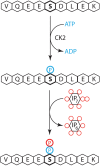Protein pyrophosphorylation: moving forward
- PMID: 27789744
- PMCID: PMC5095911
- DOI: 10.1042/BCJ20160710C
Protein pyrophosphorylation: moving forward
Abstract
Genetic ablation of inositol pyrophosphate synthesis has established the fundamental importance of this class of molecules to the eukaryote cell. These studies, however, must be complemented by cell biology and biochemical approaches to appreciate the signalling involved in the processes regulated by inositol pyrophosphates. A recent study by Chanduri et al. published in the Biochemical Journal, by integrating multiple experimental approaches, demonstrated that inositol pyrophosphates regulate intracellular vesicular movement. In particular, the vesicular transport along the microtubule that is driven by the motor protein complex dynein. Importantly, one subunit of this cellular motor, dynein 1 intermediate chain 2, undergoes serine pyrophosphorylation, a post-translational modification driven by inositol pyrophosphates. The pyrophosphorylation status of this dynein intermediate chain regulates its interaction with dynactin, which recruits the motor to vesicles. This mechanistically might explain how inositol pyrophosphates control intracellular membrane trafficking. By dissecting the serine pyrophosphorylation process, this work increases our awareness of this modification, underappreciated by the scientific literature but probably not by the eukaryotic cell.
© 2016 The Author(s).
Figures

Comment on
-
Inositol hexakisphosphate kinase 1 (IP6K1) activity is required for cytoplasmic dynein-driven transport.Biochem J. 2016 Oct 1;473(19):3031-47. doi: 10.1042/BCJ20160610. Epub 2016 Jul 29. Biochem J. 2016. PMID: 27474409 Free PMC article.
References
Publication types
MeSH terms
Substances
Grants and funding
LinkOut - more resources
Full Text Sources
Other Literature Sources
Molecular Biology Databases

